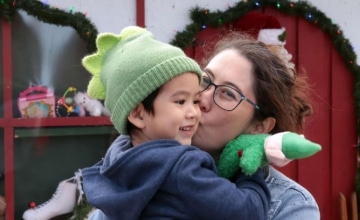Here are some ideas to keep the parent-child connection strong even if you can’t be together with your child.
As communities respond to coronavirus, many parents—especially those in health-related or public-facing jobs—are making the hard choice to keep some physical distance from their children. This change is difficult for everyone, especially our youngest children who don’t really understand why their caregiving routines are different. Here are some ideas to keep the parent-child connection strong even if you can’t be together with your child:
- Keep the communication lines open with your co-parent. Make sure you and your child’s at-home caregiver are on the same page and communicating about your child. Most importantly, how can the two of you support one another as you each manage these major life changes for your family?
- Use technology to stay connected. It may be hard to set up a specific time for a video call with your co-parent and child, especially if your work schedule changes frequently with emergency demands or interruptions. Talk with your co-parent or at-home caregiver about good and not-so-good times to call. When you can’t connect, consider texting a photo of yourself or a quick video for the at-home parent to share with your child instead. Check out five tips to make the most of video chats.
- Keep it short and sweet. Don’t be hurt if your child is done talking before you are—young children have short attention spans. If you can, try having shorter calls more frequently. Use these times to share stories, talk about your child’s day, sing songs, and try other games (like rhymes or peekaboo) that are fun for your child. (PS—Schedules at home are probably changing a lot right now so if your child is asleep, cranky, or doesn’t want to talk, remember there will be a next time.)
- Create special messages for your child. Throughout the day, send your child special messages to let them know you are thinking about them! These can be text messages or emails to your child’s caregiver (“Tell Anya I’m listening to her favorite song from Frozen!”), audio messages telling your child that you are thinking about them “Mommy is busy at the hospital today but I wanted to tell you how much I love you!”, and photos/videos. You might even use one of your child’s small toys that can be cleaned in your pictures to help your child make the connection that a part of them is with you.
- Create special messages for the away parent. Ask your child, Would you like to draw a picture for Mommy that we can save for when she’s back home? Get creative and keep an art folder to show the away parent during video calls (or to surprise them with when they return home!). Ask your toddler to tell you about their picture and write their words on the picture to share with their parent.
- Create your own book. ZERO TO THREE’S “Over There” activity book will help you to create a story perfect for your child to read over and over. It allows you to take pictures where the child is and where the away parent is, helping the young child to imagine exactly what their parent is doing, and recognizing how your child might be feeling. While originally created for military families with deployed parents, the language in the activity book can be used anytime a loved one is away from their child. Print the photos on your home computer and paste them into the activity book, or older children might want to draw their own pictures.
- Share the away parent’s scent. For infants, consider using items with the away parent’s scent during daily routines. For example, a gently worn t-shirt from the away parent can be used to swaddle baby during a feeding. Run the item through the dryer first on a high temperature to ensure it is safe. Check out When A Parent is Away: Promoting Strong Parent-Child Connections During Parental Absence to learn more.
Looking for more information? Visit zerotothree.org/coronavirus for our latest resources and updates for families.




